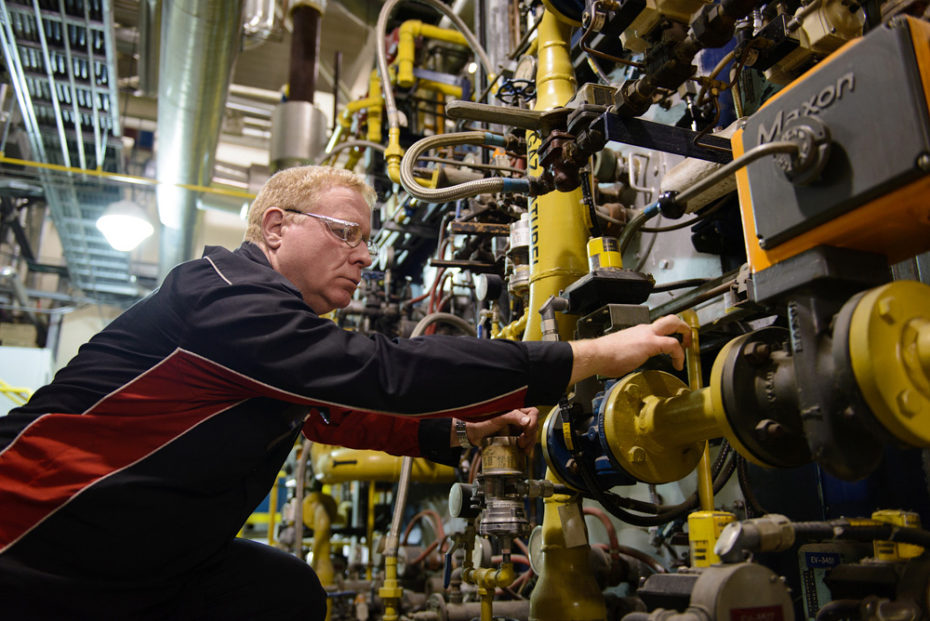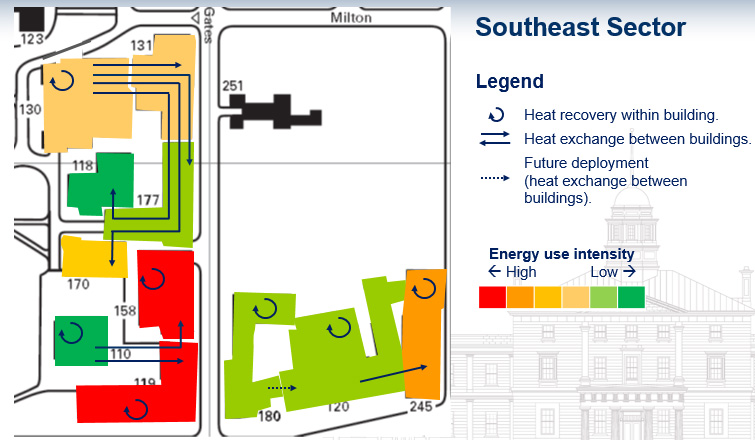
When the heating, ventilation and air-conditioning (HVAC) systems of the Otto-Maass Building were upgraded a few years ago, the University took the opportunity to create a first energy recovery loop on its downtown campus.
Energy recovery loops or “smart energy grids” consist of using the excess heat normally lost through air exhausts or generated by electrical or mechanical equipment, for example, to heat or cool other rooms or other buildings. “In this case, it was the heat generated by the data centre in Burnside Hall. That heat now provides 20 to 25 per cent of the energy needed in Otto Maass,” says Jérôme Conraud, Energy Manager, Utilities and Energy Management, a unit of Facilities Management and Ancillary Services.
In the next few years, the University will deploy energy recovery loops on most of the downtown campus. The work started last month in the south-east sector. This includes all the buildings between McConnell Engineering and Otto-Maass, as well as Royal Victoria College and the Schulich School of Music buildings.
The project involves adding, modifying and replacing HVAC equipment and components, such as chillers, heat pumps and pipes. Not all 11 buildings in the sector will be connected, but wherever possible, new energy links between buildings (see image below) will allow excess energy from one building to be recycled to heat or cool adjacent buildings.

All of this is made possible by an improved monitoring and control of all HVAC systems from the downtown campus control room. Balancing heating and cooling needs will be much easier and will significantly reduce the “shoulder season” effect experienced in some buildings.
“The shoulder season is due to the fact that in certain buildings, the air conditioning and heating equipment should preferably not function at the same time. Depending on the outside temperature, spaces can get too warm or too cool while we switch from heating our buildings to cooling them, like in the past few weeks. In most McGill buildings, that will no longer be a problem,” explains François Turcotte, Energy Portfolio Manager at Utilities and Energy Management, who is overseeing the implementation of the smart energy grids.
The work in the south-east sector is expected to take one year. The south-west and north-east sectors should follow shortly after (tentatively between 2018 and 2019). Plans for the north-west sector and the upper campus will be developed once plans for the former Royal Victoria Hospital site are known and the Stewart Biology Building renovation project is more advanced.
GHG emissions down 34 per cent since 2002
Most buildings on the downtown campus are heated with steam that flows out of the powerhouse through a network of tunnels. The energy recycled through recovery loops should help the University reduce its steam consumption and therefore the amount of natural gas needed to produce it, as well as associated greenhouse gas (GHG) emissions.
The implementation of “smart energy grids” is one of the major initiatives of McGill’s Energy Management Plan. The first phase of the plan focused on the reduction of energy consumption and resulted in a 26 per cent drop in energy use intensity (amount of energy used per square foot) and a 34 per cent decrease in building-related greenhouse gas emissions since 2002-2003.
The University achieved this through various incremental steps that included a live online monitoring of the energy consumed in 70 buildings and the replacement of old lighting fixtures with energy-efficient ones equipped with occupancy sensors in a large majority of its buildings. More recently, the replacement of the deteriorating powerhouse and heat distribution network at the Macdonald Campus also contributed to the University’s favourable results.
Both the deployment of the energy recovery loops and the new powerhouse at Mac campus have been designed so as to facilitate the future integration of renewable energy sources. As are the University’s major construction or renovation projects.
“McGill recently committed to achieving carbon neutrality by 2040. As emissions from building energy use account for two thirds of McGill’s GHG inventory, transitioning toward systems that are powered by renewable sources of energy will be key to helping us reach that goal,” says Denis Mondou, Director, Utilities and Energy Management. (Read more about McGill’s Energy Transition here.)
